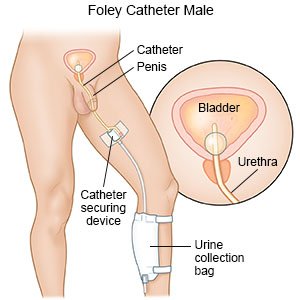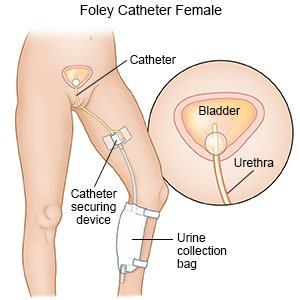Urinary Leg Bag
Medically reviewed by Drugs.com. Last updated on Aug 4, 2025.
What is a urinary leg bag?
A urinary leg bag holds urine that drains from your catheter. It fits under your clothes and allows you to do your normal daily activities.
 |
 |
Related medications
How do I use a urinary leg bag?
- Wash your hands before and after you touch your catheter, tubing, or drainage bag. Use soap and water. This reduces the risk of infection.
- Strap your leg bag to your thigh or calf. Make sure the straps are comfortable. The straps can cause problems with blood flow in your leg if they are too tight.
- Clean the tip of the drainage tube with alcohol before attaching it to your catheter. This helps prevent bacteria from getting into your catheter.
- The connecting tube should not pull on your catheter. Skin breakdown can occur if there is constant pulling on the catheter.
- Check the tube often to make sure it is not kinked or twisted. Blockage in the tube can cause urine to back up into your bladder. Your urine must flow straight through the tube into your leg bag.
- Always keep the leg bag below your bladder. This prevents urine from the bag going back into your bladder, which may cause an infection.
- Empty your leg bag when it is ½ full, or every 3 hours. A full bag may break or disconnect from the catheter.
- Change to your bedside bag before you go to bed. Your bedside bag can hold more urine. Do not use your leg bag at night because it could become too full or break.
- Clean your leg bag after every use. Fill the bag with 2 parts vinegar and 3 parts water. Let it soak for 20 minutes, then rinse and let dry. Follow your healthcare provider's instruction on replacing your leg bag with a new one.
Care Agreement
You have the right to help plan your care. Learn about your health condition and how it may be treated. Discuss treatment options with your healthcare providers to decide what care you want to receive. You always have the right to refuse treatment. The above information is an educational aid only. It is not intended as medical advice for individual conditions or treatments. Talk to your doctor, nurse or pharmacist before following any medical regimen to see if it is safe and effective for you.© Copyright Merative 2025 Information is for End User's use only and may not be sold, redistributed or otherwise used for commercial purposes.
Further information
Always consult your healthcare provider to ensure the information displayed on this page applies to your personal circumstances.
